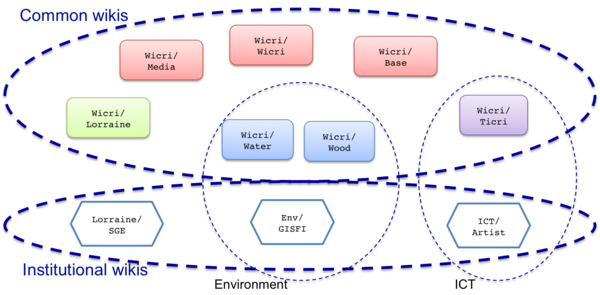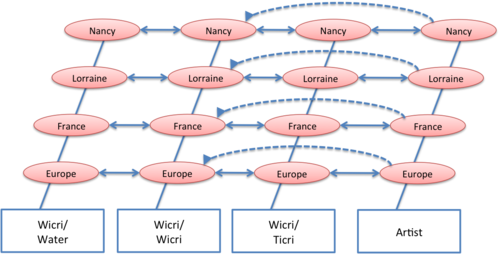Métadonnées pour WICRI, un réseau de wikis sémantiques pour les communautés de la recherche et de l'innovation
| Soumission à DC 2010 | |
|---|---|
Ce texte a été soumis au comité de programme de la conférence DC 2010.
Il a été accepté dans la section report papers, ce qui a impliqué une légère réécriture. Son écriture a fait l'objet d'un traitement collectif avec ;
|
- Titre original
- Metadata for WICRI, a Network of Semantic Wikis for Communities in Research and Innovation
- Auteurs
| Jacques Ducloy,i | Thierry Daunois,ii |
| Muriel Foulonneau,iii | Alice Hermann,iv |
| Jean-Charles Lamirel,ii | Stéphane Sire,v |
| Jean-Pierre Thomesse,ii | Christine Vanoirbeek.v |
- i - DRRT Lorraine, Metz
- ii - Université de Lorraine, Nancy
- iv - Insa de Rennes, Rennes
| Conférence DC 2010 Dublin Core Metadata Initiative Pittsburgh, du 20 au 22 octobre 2010. | |
| Un article sur les métadonnées dans WICRI y sera présenté. | |
- Résumé
- Cet article présente les enjeux des métadonnées dans le cadre du projet WICRI, un réseau de wikis sémantiques pour les communautés de la recherche et de l'innovation. Ce réseau contient des wikis appartenant à une institution, relatif à une thématique scientifique ou à une région. Les métadonnées et éléments sémantiques jouent un rôle stratégique pour garantir la qualité et assurer la cohérence du réseau. Un point important vient de la façon de travailler sur un wiki où des spécialistes de métadonnées et des scientifiques, habitués à manipuler des formalismes abstraits, peuvent intervenir ensemble sur les mêmes pages et dans la même temporalité. L'article présente quelques premières réflexions sur l'élaboration de métadonnées. Un nouveau wiki sur les métadonnées et à structure encyclopédique est proposé, avec quelques éléments techniques.
- Article
- Sur le répertoire ARTIST : version soumise, en format .doc
Sommaire
Introduction
Depuis le moment où, en 1995, Ward Cunningham a lancé WikiWikiWeb les wikis jouent un rôle de plus en plus important au sein des systèmes d'information scientifique. Les métadonnées y jouent un rôle relativement limité. Ceci vient notamment du fait que beaucoup d'applications sont isolées et de taille réduite. Cependant Wikipédia (en langue anglaise), avec ses 3 000 000 d'articles fait déjà émerger un ensemble de mode d'utilisation de métadonnées. En janvier 2010 les statistiques font apparaître un volume de 259 000 modèles et 552 000 catégories[1].
Avec un réseau de wikis la question devient immédiatement plus aigüe. Depuis bientôt 2 ans nous nous confrontons à la mise en œuvre d'un réseau de wikis sémantiques, et naturellement au besoin d'un investissement non négligeable sur les aspects métadonnées.
WICRI, un réseau de wikis pour la recherche et l'innovation
 |
| FIG. 1. Le réseau WICRI (un extrait) |
Ecrire dans un réseau d'hypertextes avec des formules et des métadonnées
Conclusion
Bibliographie
- Bizer, Christian; Lehmann, Jens; Kobilarov, Georgi; Auer, Soren; Becker, Christian; Cyganiak, Richard; Hellmann, Sebastian (September 2009). "DBpedia - A crystallization point for the Web of Data". Web Semantics: Science, Services and Agents on the World Wide Web 7 (3): 154-165. ISSN 1570-8268
- Correndo, G., Alani, H., & Smart, P. (2008). A community based approach for managing ontology alignments. In The 7th International Semantic Web Conference (p. 61). From http://eprints.ecs.soton.ac.uk/16673/
- Ducloy, Jacques, Yann Nicolas, Diane Le Hénaff, Muriel Foulonneau, Luc Grivel, Jean-Paul Ducasse. Metadata towards an e-research cyberinfrastructure: the case of francophone PhD theses. Proceedings of DC 2006, Manzanillo, Mexico, 2006. , from http://dcpapers.dublincore.org/ojs/pubs/article/view/846.
- EuroCRIS (2009). Recording Research. Report for CRIS seminar September 2009. Retrieved February 10, 2010, from http://www.eurocris.org/fileadmin/Upload/200909.pdf
- Hodis, Eran (2008), Jaime Prilusky, Eric Martz, Israel Silman, John Moult and Joel L. Sussman. Proteopedia - a scientific 'wiki' bridging the rift between 3D structure and function of biomacromolecules, Genome Biology 2008, doi:10.1186/gb-2008-9-8-r121. From http://genomebiology.com/2008/9/8/R121
- Jeffery, Keith (2007). Technical Infrastructure and Policy Framework for Maximising the Benefits from Research. Proc. of the 11th Int. Conf. on Electronic Publishing, Vienna, Austria 13 June 2007. Leslie Chan and Bob Martens. ISBN 978-3-85437-292-9, 2007, pp. 1-12, from http://citeseerx.ist.psu.edu/viewdoc/download?doi=10.1.1.102.5044
- Krötzsch, Markus, Denny Vrandecic, Max Völkel, Heiko Haller, Rudi Studer (2007). Semantic Wikipedia. In: Journal of Web Semantics 5/2007, pp. 251–261. Elsevier 2007.
- Lagoze, Carl, Dean Krafft, Sandy Payette, and Susan Jesuroga. (2005, November). What is a digital library anyway, anymore? Beyond search and access in the NSDL. D-Lib Magazine, 11(11). Retrieved, January 10, 2007, from http://www.dlib.org/dlib/november05/lagoze/11lagoze.html.
- Lamirel, Jean-Charles (2006), and Shadi Al Shehabi. MultiSOM: a multiview neural model for accurately analyzing and mining complex data. In Proceedings of the 4th International Conference on Coordinated & Multiple Views in Exploratory Visualization (CMV), London, UK, July 2006.
- Lange, Christoph (2008). SWiM – a semantic wiki for mathematical knowledge management. In Sean Bechhofer and al, editors, ESWC, volume 5021 of Lecture Notes in Computer Science, pages 832–837. Springer, 2008.
- Sarre, S., Foulonneau, M. (2010) "Reusability in e-assessment : Towards a multifaceted approach for managing metadata of e-assessment resources", Fifth International Conference on Internet and Web Applications and Services.
- Sire, Stéphane (2010), Christine Vanoirbeek, Vincent Quint, Cécile Roisin. Authoring XML all the Time, Everywhere and by Everyone. Proc. of XML Prague 2010, p. 125-149, Institute for Theoretical Computer Science, March 2010.
- Fabian M. Suchanek, Gjergji Kasneci, and Gerhard Weikum. 2007. Yago: a core of semantic knowledge. In Proceedings of the 16th international conference on World Wide Web (WWW '07). ACM, New York, NY, USA, 697-706. DOI=10.1145/1242572.1242667 http://doi.acm.org/10.1145/1242572.1242667
- Tifous, A., El Ghali, A., Dieng-Kuntz, R., Giboin, A., Christina, C., and Vidou, G. 2007. An ontology for supporting communities of practice. In Proceedings of the 4th international Conference on Knowledge Capture (Whistler, BC, Canada, October 28 - 31, 2007). D. Sleeman and K. Barker, Eds. K-CAP '07. ACM, New York, NY, 39-46. DOI= http://doi.acm.org/10.1145/1298406.1298415
- Tudorache, Tania (2008), Natalya F. Noy, Samson Tu and Mark A Musen. Supporting Collaborative Ontology Development in Protégé. In: Lecture Notes In Computer Science; Vol. 5318 archive Proceedings of the 7th International Conference on The Semantic Web


